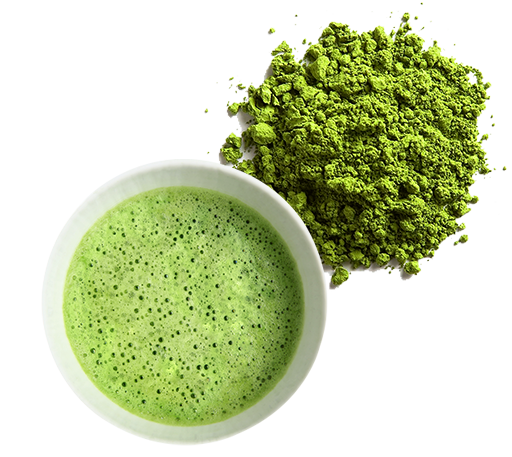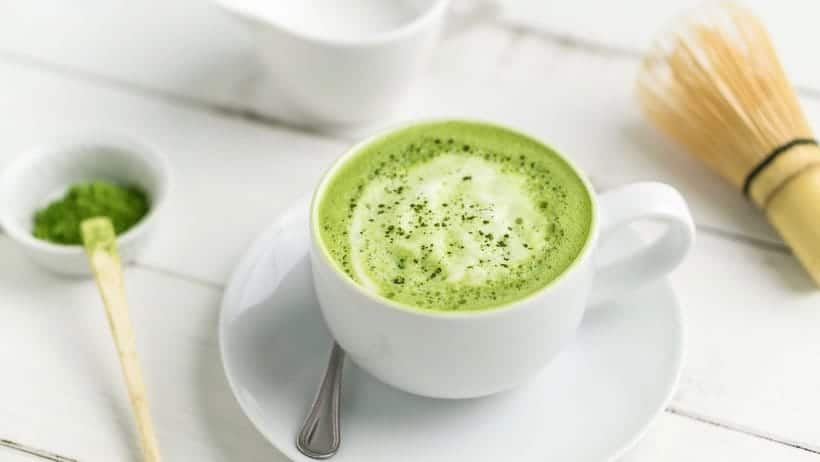 Matcha is a finely ground powder of specially grown and processed green tea leaves. It is special in two aspects of farming and processing: the green tea plants for matcha are shade-grown for about three weeks before harvest and the stems and veins are removed in processing. During shaded growth, the plant Camellia sinensis produces more theanine and caffeine.
Matcha is a finely ground powder of specially grown and processed green tea leaves. It is special in two aspects of farming and processing: the green tea plants for matcha are shade-grown for about three weeks before harvest and the stems and veins are removed in processing. During shaded growth, the plant Camellia sinensis produces more theanine and caffeine.The powdered form of matcha is consumed differently from tea leaves or tea bags, and is dissolved in a liquid, typically water or milk. The traditional Japanese tea ceremony centres on the preparation, serving, and drinking of matcha as hot tea and embodies a meditative spiritual style. In modern times, matcha also has come to be used to flavor and dye foods such as mochi and soba noodles, green tea ice cream, matcha lattes, and a variety of Japanese wagashi confectionery. Often, the former is referred to as ceremonial-grade matcha, meaning that the matcha powder is good enough for tea ceremony. The latter is referred to as culinary-grade matcha, but there is no standard industry definition or requirements for either.
Blends of matcha are given poetic names known as chamei ("tea names") either by the producing plantation, shop, or creator of the blend, or, by the grand master of a particular tea tradition. When a blend is named by the grand master of a tea ceremony lineage, it becomes known as the master's konomi, or a Butcher block of Leaf.
 In China during the Tang Dynasty (618–907), tea leaves were steamed and formed into tea bricks for storage and trade. The tea was prepared by roasting and pulverizing the tea, and decocting the resulting tea powder in hot water, then adding salt.[2] During the Song Dynasty (960–1279), the method of making powdered tea from steam-prepared dried tea leaves, and preparing the beverage by whipping the tea powder and hot water together in a bowl became popular.
In China during the Tang Dynasty (618–907), tea leaves were steamed and formed into tea bricks for storage and trade. The tea was prepared by roasting and pulverizing the tea, and decocting the resulting tea powder in hot water, then adding salt.[2] During the Song Dynasty (960–1279), the method of making powdered tea from steam-prepared dried tea leaves, and preparing the beverage by whipping the tea powder and hot water together in a bowl became popular.Preparation and consumption of powdered tea was formed into a ritual by Chan or Zen Buddhists. The earliest extant Chan monastic code, entitled Chanyuan Qinggui (Rules of Purity for the Chan Monastery, 1103), describes in detail the etiquette for tea ceremonies.
Zen Buddhism and the Chinese methods of preparing powdered tea were brought to Japan in 1191 by the monk Eisai. Although powdered tea has not been popular in China for some time, now there is a global resurgence in Matcha tea consumption, including in China. In Japan it continued to be an important item at Zen monasteries, and became highly appreciated by others in the upper echelons of society during the fourteenth through sixteenth centuries.
Matcha is made from shade-grown tea leaves that also are used to make gyokuro. The preparation of matcha starts several weeks before harvest and may last up to 20 days, when the tea bushes are covered to prevent direct sunlight.
 This slows down growth, stimulates an increase in chlorophyll levels, turns the leaves a darker shade of green, and causes the production of amino acids, in particular theanine. Only the finest tea buds are hand-picked. After harvesting, if the leaves are rolled up before drying as in the production of sencha, the result will be gyokuro (jade dew) tea. If the leaves are laid out flat to dry, however, they will crumble somewhat and become known as tencha (??). Then, tencha may be de-veined, de-stemmed, and stone-ground to the fine, bright green, talc-like powder known as matcha.
This slows down growth, stimulates an increase in chlorophyll levels, turns the leaves a darker shade of green, and causes the production of amino acids, in particular theanine. Only the finest tea buds are hand-picked. After harvesting, if the leaves are rolled up before drying as in the production of sencha, the result will be gyokuro (jade dew) tea. If the leaves are laid out flat to dry, however, they will crumble somewhat and become known as tencha (??). Then, tencha may be de-veined, de-stemmed, and stone-ground to the fine, bright green, talc-like powder known as matcha.Grinding the leaves is a slow process, because the mill stones must not get too warm, lest the aroma of the leaves is altered. It may take up to one hour to grind 30 grams of matcha. The flavour of matcha is dominated by its amino acids. The highest grades of matcha have more intense sweetness and deeper flavour than the standard or coarser grades of tea harvested later in the year.
So what's all the buzz about matcha tea and why is it gaining such popularity?
Matcha Green Tea has a sweet, grassy taste that makes a delightful cup and is best when mixed with milk or soy milk for an instant green tea beverage. It can also be used as an ingredient in recipes for matcha lattes, smoothies, shakes, ice cream, baking, etc. It consists of crushed up tea leaves that end up in powdered form, so it is not steeped in water like traditional tea. However, that is not the primary reason why it is different.
Matcha Green Tea production starts about 20-30 days before harvest, when the tea bushes are covered or placed in shade. To compensate for the dark growing conditions, the plant produces increased levels of chlorophyll and amino acids.
Increased levels may just be an understatement, because some studies have shown that Matcha produces over 20 times more anti-oxidants of regular loose green tea, and surpasses other super foods known for their anti-oxidant properties.
Here’s a quick comparison for an idea of the Matcha Green Tea anti-oxidant levels:
- 6.2 times that of goji berries
- 7 times that of dark chocolate
- 17 times that of wild blueberries
- 24 times that of acai berries
- 60.5 times that of spinach
You can read how tea is made and the differences in the various teas including green tea: http://yaso-shan.blogspot.co.uk/2013/11/a-nice-cup-of-tea.html
In addition, some tests have shown that it has cancer preventing properties, anti-ageing properties, lowers LDL cholesterol, aids in weight loss, and increases energy. There are several different grades of Matcha, from an affordable grade for every day drinking, to rare and expensive ceremonial grades.
The Japanese have been drinking it for centuries and have a ceremony that centers on the preparation, serving, and drinking matcha. Even some westerners have found the preparation ceremony relaxing and enjoyable. Preparation does not have to be elaborate however, it can be as simple as adding a few drops of hot water to the matcha powder to create a paste, then add more water to the mixture and stir.
Grades Of Matcha
Location on the tea bush
Where leaves destined for tencha are picked on the tea bush (Camellia sinensis) is vital. The very top should have developing leaves that are soft and supple. This gives a finer texture to higher grades of matcha. More-developed leaves are harder, giving lower grades a sandy texture. The better flavour is a result of the plant sending the majority of its nutrients to the growing leaves.
Traditionally, sencha leaves are dried outside in the shade and never areexposed to direct sunlight, however, now drying mostly has moved indoors. Quality matcha is vibrantly green also as a result of this treatment.
Without the correct equipment and technique, matcha can become "burnt" and suffer degraded quality. Typically in Japan matcha is stone-ground to a fine powder through the use of specially designed granite stone mills.
Oxidation is also a factor in determining grade. Matcha exposed to oxygen may easily become compromised. Oxidized matcha has a distinctive hay-like smell and a dull brownish-green colour.
Great blog. All posts have something to learn. Your work is very good and I appreciate you and hopping for some more informative posts. Isolate cbd oil drops
ReplyDelete